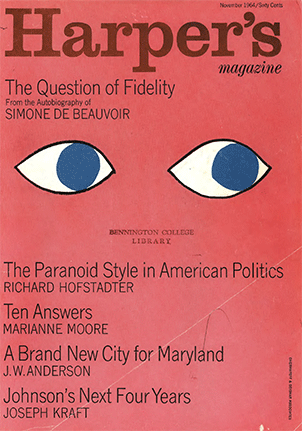Richard Hofstadter’s “The Paranoid Style in American Politics” (1964)
“American politics has often been an arena for angry minds.”
In his Easy Chair column this month, Thomas Frank revisits the historian Richard Hofstadter’s famous essay, “The Paranoid Style in American Politics,” whose fiftieth anniversary of publication will be November of this year. “To read Hofstadter’s 1964 essay,” Frank writes,
is to experience numerous shocks of recognition. To begin with, Hofstadter noted that what distinguishes “the modern right wing” is that it “feels dispossessed: America has been largely taken away from them and their kind.” . . . The notion that the righteous have been dispossessed is by now so utterly ingrained that conservatives have stopped mincing words about the remedy: they must “take our country back” from the elites and socialists who have stolen it away.
Frank highlights other still-evident traits of the paranoid style, but ultimately lands on a problematic legacy of the essay: its popularization of a “pseudopsychological approach” to political analysis, under which Sarah Palin can be swiftly dismissed as a delusional maniac, or Bill O’Reilly as a narcissist. “We should also note,” Frank writes, “that nowadays the source of the psychiatric style is nearly always the liberal camp.”
Hofstadter was writing at a peak moment of liberal self-confidence, leading Frank to conclude by lamenting the waning of the possibilities presented by that historical moment. “Hofstadter’s warm old liberal consensus was itself in pieces only a few years later — shattered first by its own blunders in Vietnam and then by the leaders of the ‘paranoid’ right.”
Read Richard Hofstadter’s “The Paranoid Style in American Politics”
Read Thomas Frank’s Easy Chair column, “Tears for Fears” (subscription required)





